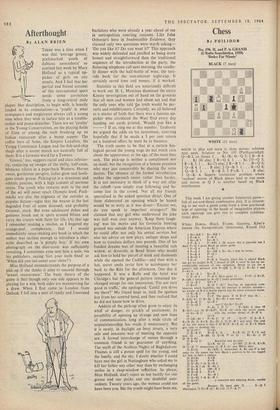Chess
By PHILIDOR No. 196. 11. and P. le GRAND (L'Italia Scacchistica, 1959) 'Doke Far Niente'
BLACK (7 men)
WHITE (II men) '
wurre to play and mate in three moves; solution next week. Solution to No. 195 (Parthasarathy): Q—B 2, no threat. 1 . . . Kt (Kt 4)—Q 5; 2 B—B 4. 1 . . . Kt (4) else; 2 R—Q 6. 1 . . . Kt (7)—Q 5; 2 R—K 5. 1 ... Kt (7) else; 2 R—B 5. 1 B—Q 5; 2 Q—B 4. 1 . . . B else; 2 Q—B 5. 1 . . . R—Q 4; 2 Q—B 5. 1 . . . R—B 5; 2 P x R. I . . . R else; 2 Q—K 4. Superb 'correction' problem where 'random' moves of Black pieces lead to one mate and moves to Q 5 to another based op Black interference.
*.
This week I am giving another Interzonal game— full of cut-and-thrust combinative play. It is interest- ing to see such a game come from a slow positional type of opening; in the hands of imaginative players such openings can give rise to complex combina- tional play.
White, DARGA. Black, EvANS. Opening, KING'S INDIAN (by transposition). (Interzonal, Round 13.)
1 Kt—KB 3 Kt—KB 3 2'P—B 4 P—B 4 3 Kt—B 3 Kt—B 3
4 P—K 3 P—KKt 3. Of course this is playable but I think P—Q 4 gives Black an easier game.
5 P—Q 4 B—Kt 2 6 P—Q 5 Kt—QR 4. Kt—Kt 1 may be better.
P—K 4 P—Q. 3 8 B—Q 3 0-0 9 0-0 P—K 4. Usually when this is played Black
can get his knight to K 2 instead of QR 4—now he has an un- comfortable mixture of two variations. Better to try for a queen's aide advance with P—QR 3, B—Q 2, R—Kt 1 and P—Kt 4.
10 Kt—K t Kt—K I II P—B 4 P—B 4. Here again II PxP; 12 BXP, P—QR 3 followed by B—Q 2 looks preferable, 12 Q—B 2 KPxP 13 BXP B—Q 5 chi? Starting an ingenious com- bination which backfires, but his position is inferior anyway— his knight on R 4 is poorly placed and his pawn structure worse. 14K—RI BXKt 15 QXB P XP. The point. If 16 BxP then 16 : . . P—KKt 41; 17 Q—Kt 3. Kt—Kt 2 and wins.
16 B—K 21 Q—B 3 17 Q—Q 2 ... not 17 QXKt? QXP1
17. . P—Kt 3. If 17 . . . P—KKt 4; then 18 B—K3!—not 18 BXKtP?, QxR chi—with the better game.
18 Kt—B 21wtth the terrible threat of B—R 6. 18 . . . o'x'P 19 QR—Kt I P—K 6! If 19 . . . Q xP; 20 B—R 6, RxR ch; 21 RXR, Kt—Kt 2; 22 Q—B 3 and wins. The idea of the text move is that if 20 BXP, R x R ch; 21 R x R Black gets time to develop, but . . 20 QXP!! QXKt 21 B—R 61 B—B 4. 21. . . R X R ch; 22 R x R and now 22 . B—B4; 23 Q—K 7! or 22 . . . Kt—Kt 2; 23 Q—K 8 ch! 22 B—Q 3!. . Beautiful and decisive.
22 . . . QX.R. Or 22 ... QXRP; 23 Bxl3, Rx13; 24 Q—K 71 threatening Q—B B ch! and White wins.
23 BxQ Kt—KKt 2. Sometimes R, Kt and P' is fair value for the queen but here Black's position is far too ragged for him to have a chance.
24 BxKt Kx13 25 BXB P X B 26 Q—Kt 3 ch K—R 1 27 Q—B 3 ch K—Kt 1 28 R—K I QR—K I 29 R—K 6 RxR 30 PxR Kt—B 3 31 Q—Kt 3 ch K—R 1 32 Q X P! . . . a beautiful and amusing finish, worth) of the game.
32. . Resigns. He must play 32 . R—Q I whereupon '32 Q X R chi. Kt XQ; 33 P—K 7!


































 Previous page
Previous page